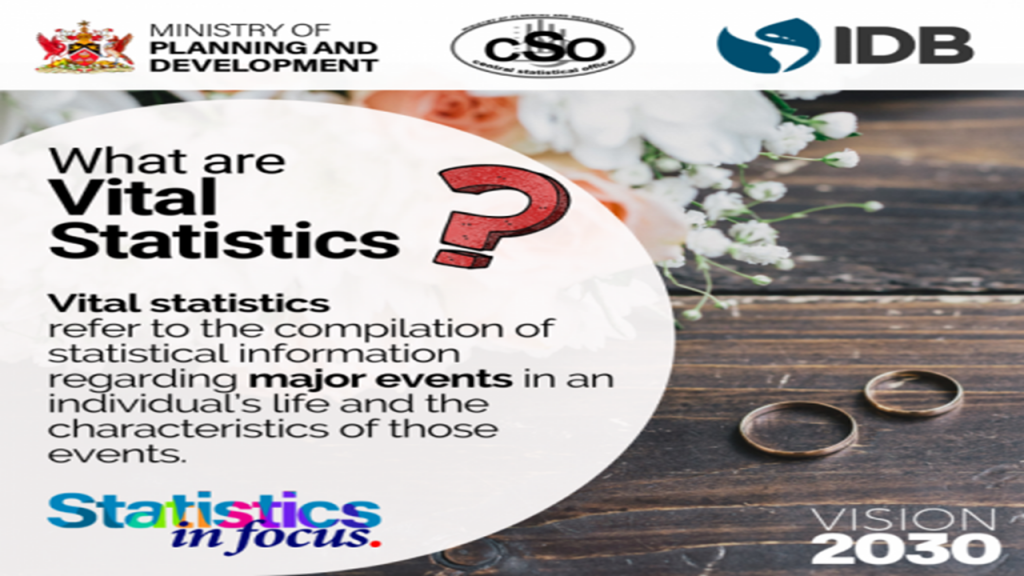Vital statistics refer to the compilation of statistical information regarding major events in an individual’s life and the characteristics of those events. Vital statistics include numbers and rates of births and related key characteristics such as births by sex, location and maternal age. It also includes numbers and rates of deaths as well as key characteristics such as age, sex, location and cause of death. Events related to civil status – marriage and divorce are also recorded. The knowledge and interpretation of vital statistics is essential to social and economic development as well as the measurement of common demographic indicators such as the quality of life. Vital statistics offer crucial information on the population of any given country.
Vital statistics are the result of civil registration process; this process addresses all the procedures involved in the recording, maintenance and storage of vital events. The principles of a vital statistical system are universal coverage, confidentiality of personal information, continuity, and regular dissemination. Universal coverage ensures that every population group in every geographical area is included. Confidentiality of personal information provides assurance that any personal information collected will be safeguarded and used only for authorised statistical and administrative purposes. Continuity highlights the need for timely data that reflects short, long and seasonal changes. Regular dissemination establishes the importance of regularly scheduled, short term compilation of statistical information along with annual tabulation and analysis with related socio-economic characteristics. The adherence to these principles can promote a robust vital statistical system which in turn bolsters social, regional and developmental planning.
Vital statistics can be used for a variety of purposes but expressly support national development by:-
Estimating the size and growth of a population
This information is critical to measure the annual change in population size, to adequately allocate resources and to perform regional planning.
Implementing and evaluating public health programs
Access to timely data about fertility and mortality can give early insight into trends that may impact on the health and safety of citizens.
Understanding social and economic dynamics
Fertility and mortality statistical information proves a useful tool for understanding socioeconomic differences in a population and estimating life expectancy.
Producing development indicators
The measurement of key social and demographic factors affecting quality of life is a crucial indicator of developmental progress.
Monitoring vital statistics using the civil registration systems is one of the essential tools employed in the provision of services to those in need. Other sources for obtaining vital statistics data are censuses, demographic and health surveys and population registers. International Agencies such as the United Nations Statistics Division, the International Institute for Vital Registration and Statistics, UNICEF’s Multiple Indicators Cluster Survey, The Demographic and Health Surveys Program and the World Health Organisation are also sources of this type of information.
Vital statistics are increasingly being recognized as critical for good governance and addressing human rights concerns. Linkages between vital statistics and the Development Goals (SDGs) are imperative for development frameworks. No hunger, the second SDG, relies on statistical information on the number of pregnancies and number of births to accurately measure the needs of the population.
The fourth SDG – quality education – depends on completed birth registration information so that children can be formally processed to attend school.
Peace, justice and strong institutions – SDG 16 – requires information on mortality rates as well as characteristics on the age and cause of death so that issues of violence, disease and abuse may be adequately addressed in a society. Population social and vital statistics play a key role in helping countries to measure and meet their SDG objectives.
The Central Statistical Office (CSO) of Trinidad and Tobago is tasked with the role of collecting, processing and disseminating statistical information. The strengthening of the National Statistical System (NSS) offers the opportunity to anticipate and meet the current and future statistical demands of the nation. The Population Social and Vital Statistics Division will be focusing on providing data in a more timely manner using the best practices recommended by the United Nations Statistical Division.
